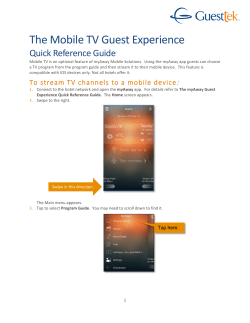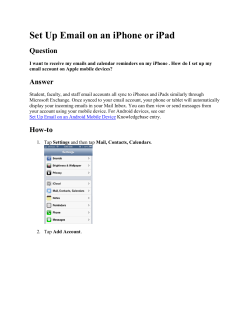
File
Air Masses and Fronts: How weather changes Air Mass • A large body of air with similar –Temperature –Humidity –Air pressure • Air masses form over large land or bodies of water. MAP TAP 2002-2003 Weather Fronts 2 • Whether an air mass is warm or cold depends on the temperature over which the mass forms. 4 types of air masses 1.Tropical 2.Polar 3.Maritime 4.Continental MAP TAP 2002-2003 Weather Fronts 3 Continental - Forms over land Weather Fronts 4 Maritime - •Maritime air masses form over water. MAP TAP 2002-2003 Weather Fronts 5 Polar • Polar means it forms over the poles. • COLD! MAP TAP 2002-2003 Weather Fronts 6 Tropical • Form over the tropics (near the equator) • WARM!! MAP TAP 2002-2003 Weather Fronts 7 MAP TAP 2002-2003 Weather Fronts 8 • Whether an air mass is warm or cold depends on the temperature over which the mass forms. • 4 types of air masses 1. Tropical – warm air masses that form over the tropics. 2. Polar – cold air masses that form over the poles. 3. Maritime – air masses that form over the ocean (very humid) 4. Continental – form over land – (are dry) MAP TAP 2002-2003 Weather Fronts 9 Fronts • Where air masses meet but do not mix because of different temperatures and densities MAP TAP 2002-2003 Weather Fronts 10 Fronts • 4 kinds of fronts: – Cold front – Warm front – Occluded front – Stationary front MAP TAP 2002-2003 Weather Fronts 11 Cold Front • A cold air mass is replacing a warmer air mass. • Shown on a weather map by a blue line with triangles pointing the direction the cool air is moving. Cold Front Cold Front 1. Rapidly moving cold air mass runs into a slowly moving warm air mass. 2. The denser cold air slides under the lighter warm air pushing it upward. 3. The rising air cools and condenses, forming clouds. 4. Heavy rain or snow may fall. 5. If the warm air mass contains only a little water vapor, there may be only cloudy skies. MAP TAP 2002-2003 Weather Fronts 14 Fronts: Five Types of Fronts 1. Cold Front: The zone where cold air is replacing warmer air • Air gets drier after a cold front moves through NSF North Mississippi GK-8 Cold Front • Cold fronts move quickly and can cause abrupt weather changes including violent thunderstorms • After a cold front passes through, cool, dry air moves in. • Clear skies and cooler temperatures often follow. MAP TAP 2002-2003 Weather Fronts 16 Warm Front • Warm air mass • collides with a slowly moving cooler air mass. Shown on a weather map by a red line with half circles pointing the direction the warm air is moving. MAP TAP 2002-2003 Weather Fronts 17 Warm Front • Moving warm air mass collides with a slowly moving cold air mass. • The warm air moves over the denser cold air. • If the warm air is humid, showers and light rain fall along the front where the warm and cold air meet. • If the warm air is dry scattered clouds form. MAP TAP 2002-2003 Weather Fronts 18 Fronts: Five Types of Fronts 2. Warm Front: The zone where warm air is replacing colder air • Air gets more humid after a warm front moves through NSF North Mississippi GK-8 Warm Front • Because warm fronts move more slowly than cold fronts, the weather may be rainy or foggy for several days. • After the warm front passes, the weather is likely to be warm and humid. • In winter, warm fronts bring snow. MAP TAP 2002-2003 Weather Fronts 20 Comparing Warm and Cold Fronts • Cold fronts move faster than warm fronts. • The weather activity in a cold front is often violent and happens directly at the front. • Cold fronts have sudden gusty winds high in the air creating turbulence. • The weather activity in a warm front generally happens before the front passes. • In a warm front the cloud formation is very low often creating situations of poor visibility. MAP TAP 2002-2003 Weather Fronts 21 Occluded Fronts • When a warm • front is trapped by 2 cold fronts. Shown on a weather map by a purple line with alternating triangles and semicircles pointing the direction the front is moving. MAP TAP 2002-2003 Weather Fronts 22 Occluded Fronts • A warm air mass is caught between two cooler air masses. • The denser cool air masses move underneath the less dense warm air and push it upward. • The temperature near the ground becomes cooler. MAP TAP 2002-2003 Weather Fronts 23 Occluded Fronts • The warm air mass is cut off, or occluded, from the ground. • As the warm air cools and its water vapor condenses, the weather may turn cloudy and rainy or snowy. MAP TAP 2002-2003 Weather Fronts 24 Fronts: Five Types of Fronts 4. Occluded Front: Formed when a cold front overtakes a warm front • This occurrence usually results in storms over an area • In U.S., the colder air usually lies to the west NSF North Mississippi GK-8 Stationary Fronts • A front that stops moving or is moving very slowly. • Shown on a weather map with alternating red semicircles pointing away from the warm air and blue triangles pointing away from the cold air. MAP TAP 2002-2003 Stationary Fronts • Sometime cold and warm air masses meet, but neither has enough force to move the other. • They meet in a “standoff” MAP TAP 2002-2003 Weather Fronts 27 Stationary Fronts • Where the warm and cool air meet, water vapor in the air condenses into rain, snow, fog, or clouds. • It may stall over an area and bring many days of clouds and precipitation. MAP TAP 2002-2003 Weather Fronts 28
© Copyright 2025









